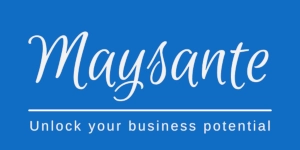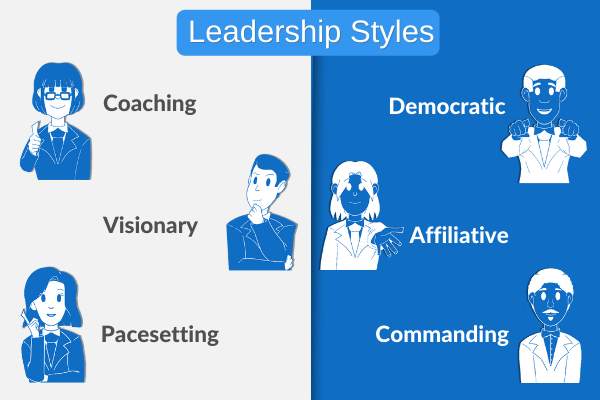We all have role models we look up to. The qualities they demonstrate, together with their leadership style may influence why you chose them as role models. Understanding leadership styles will help you to know what your style is. It will help you to be your authentic self as a leader. To become more effective.
Leadership Styles
It’s important you understand that leadership styles can change depending on the situation. Emotional intelligence plays a key part in understanding the impact of your emotions and behaviours at work. Because it provides insights into how emotions affect performance and relationships at work. David Goleman describes six leadership styles based on emotional intelligence. These are visionary, affiliative, coaching, democratic, pacesetting and commanding leadership styles.
Visionary Leadership Style
A key strength of a visionary leader is your ability to see the big picture. You can focus on the long-term trajectory. You’ll communicate your vision to others in a way that inspires and motivate them to share in your vision. You empower them by sharing knowledge. As a visionary leader, you understand the value of bringing people along with you. The need for flexibility, clarity, empathy, communication, commitment and reward. To achieve your vision, you need to be able to implement it. Visionary leadership skills can also apply to short term plans. You can use your ability to paint the picture to help others to gain clarity and focus. As a result, they understand what you are trying to achieve.
If used correctly, visionary leadership can have a positive impact on the team. It can steer them towards achieving a common goal. But your focus on the vision may mean that you don’t put any effort into the present goals. People may become excited at the beginning. But may lose interest if the implementation is too far into the future. You may struggle to motivate more experienced colleagues
Coaching Leadership Style
Coaching leadership is about developing your team by coaching them. You help prepare them for the future. You create strong links between organisational and personal goals. This results in a high degree of commitment, engagement and loyalty. The individuals you are coaching may end up becoming coaches themselves. Hence, the impact of the coaching leadership style may be long lasting.
It can however be time-consuming to coach your team. For it to work your team must be open to being coached. You also need to have the necessary skills to be able to coach them. You could come across as micromanaging if you don’t carry it out correctly.
Affiliative Leadership Style

An affiliative leader prioritises people and relationships. You put a lot of effort into getting to know your team on a personal level. Your preference is for everyone to be happy. You build stronger bonds and trust with your team. There is more emphasis on interpersonal relationship building than work. You provide a lot of feedback, reward and recognition. Affiliative leadership style leads to high team morale and collaborative working.
A lot hinges on relationships and bonds, if you are not authentic, it can lead to distrust. Too much praise will have a negative impact.
Holding your team accountable may be hard due to the personal relationships you have. This may in turn affect productivity. However, this style of leadership can be advantageous when the team is under a lot of pressure. Or when the team needs to recover from a very challenging project or rebuild trust.
Affiliative leadership is often complementary to visionary leadership.
Democratic Leadership Style
Democratic leadership involves the entire team in the decision-making process. You have an interest in your team’s views and input. You’ll listen to and consider all views – good or bad. You encourage open communication, idea sharing and full participation. Your team will feel empowered and confident in coming up with ideas and being creative. It is particularly useful when you need fresh ideas or needs the team’s buy-in to progress.
However, you need to make sure that your team members have enough information to inform their views and decisions. Democratic leadership style may not be the best leadership style when urgent decisions need to be made.
Pacesetting Leadership
You strive for excellence as a pacesetting leader. Your approach is to encourage others to work hard and aim for excellence too. You lead by example. You drive high standards and performance and will not settle for less. Pacesetting leadership may work well if you are looking for quick results from a motivated and skilled team.
This leadership style is great for achieving short term results. But it can be problematic over the long term. Team members may become exhausted and stressed out. They can become demotivated and uninspired.
Commanding Leadership
You lead by commanding and controlling your team. You lean into your position of power and authority and expect your team to do as you say. You’re are the decision-maker. What you say is non-negotiable. This style of leadership may work well in a low-skilled team environment. An environment where micromanagement is usually required to get things done. You will however struggle to succeed in a highly skilled team environment. An environment where innovation, creativity and engagement are usually required. You will come across as emotionally detached and distanced from your team.
How do you know your authentic leadership style?
Tapping into your emotional intelligence will help you determine which of the leadership styles is best suited to you. And for the situation, you find yourself in. Out of the six styles, you should aim to use visionary, affiliative, coaching and democratic more often. You should limit the number of times that you use pacesetting and commanding leadership.
Understand emotions and behaviours at work, and how they impact relationships and performance. Also, consider your leadership style and how it affects your teams’ performance and productivity. Be authentic. Lead and inspire.

